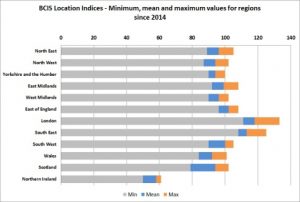The BCIS Location Indices have become increasingly volatile and BCIS regularly receives queries about the change in location indices for one region or another
An ideal location index would show the current location differences for every location in the UK- but BCIS is constrained by the data available to calculate these location indices, which are projects indexed for its tender price indices.
If you have concerns about a specific location, you can help by identifying projects that BCIS can index to improve the sample.
Using just the latest project indices gives a current figure but the number of projects is so small that regional indices are unreliable and it is impossible to calculate country or distinct indices.
Increasing the time span gives more confidence in the regional indices but a much longer time span is needed before good coverage of reliable county indices is available, with a consequent loss of currency. There is a trade-off between currency and volatility.

Recent project indices
To overcome this, BCIS uses recent project indices to calculate the current regional price levels and uses data from over 35 years to measure how counties and districts compare with their region. This assumes that the relationship between a county or district and the region as a whole is constant over the long term – which is clearly only approximately true.
Calculating the current regional indices is based on a form of exponential smoothing: projects are weighted according to how old they are so that a project in the latest quarter is given a weight of 1.00, a project in the previous quarter 0.75, two quarters back 0.56 and so on. The actual values used for those weights have been adjusted over the years in response to the fall in the number of project indices available. The weight for a project from the previous quarter has been increased from 0.60 to 0.65 (May 2015) and 0.75 (May 2016) and it is being increased further, in small steps, to 0.80.
‘How current are the location indices?’
One question that often arises is ‘how current are the location indices?’ The answer to this is not straightforward as it depends on the sample of projects in each region and quarter, but based on the current weightings the index represents prices back seven quarters.
BCIS is looking at a range of responses to the volatility of the location indices. Improving the sample size is the most obvious and effective answer and steps have already been taken to index more projects.
Anyone who has an interest in the quality of location indices is urged to send priced bills of quantity or quantified schedules to BCIS for indexing. A longer-term project is looking at alternative measures of tender prices, but it is not clear at this stage whether they will be suitable for calculating location indices.
The weighting can also be used to adjust the balance between volatility and currency: increasing the weighting factor as described above gives more projects influence in the regional index calculation and thus reduces volatility, but at the cost of the apparent age of the indices increasing.
If you can help improve the data for the location indices, contact the Data Delivery Team on 020 7695 1700, or e-mail the BCIS data team.

















limitation of using online BCIS data for bench mark life cycle costs